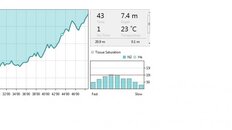Thanks for the responses. I was wanting feedback from other divers on whether they thought this rule was a good idea and why or why not. Seems the general consensus is that the rule is overly conservative. Does anyone know if this is a general rule promoted by SSI ?
As noted about, the graphs of tissue saturation indicated at some stages of the dive some tissue exceeded no decompression limits even with the ten minute buffer. That was a concern. There is no provision on the dive charter boats for dealing with a diver who goes into decompression (ie. spare tanks in the water) and we surface with 50 bar (725 psi) in the tank.
I don't have a good operational understanding of what to do if you do exceed no decompression limits. This is not taught or discussed at this level of diving. I'm not even sure if my computer would provide guidance on decompression stops needed if I did exceed the no decompression limits. The rule is plainly - don't exceed no decompression limits.
As noted about, the graphs of tissue saturation indicated at some stages of the dive some tissue exceeded no decompression limits even with the ten minute buffer. That was a concern. There is no provision on the dive charter boats for dealing with a diver who goes into decompression (ie. spare tanks in the water) and we surface with 50 bar (725 psi) in the tank.
I don't have a good operational understanding of what to do if you do exceed no decompression limits. This is not taught or discussed at this level of diving. I'm not even sure if my computer would provide guidance on decompression stops needed if I did exceed the no decompression limits. The rule is plainly - don't exceed no decompression limits.







